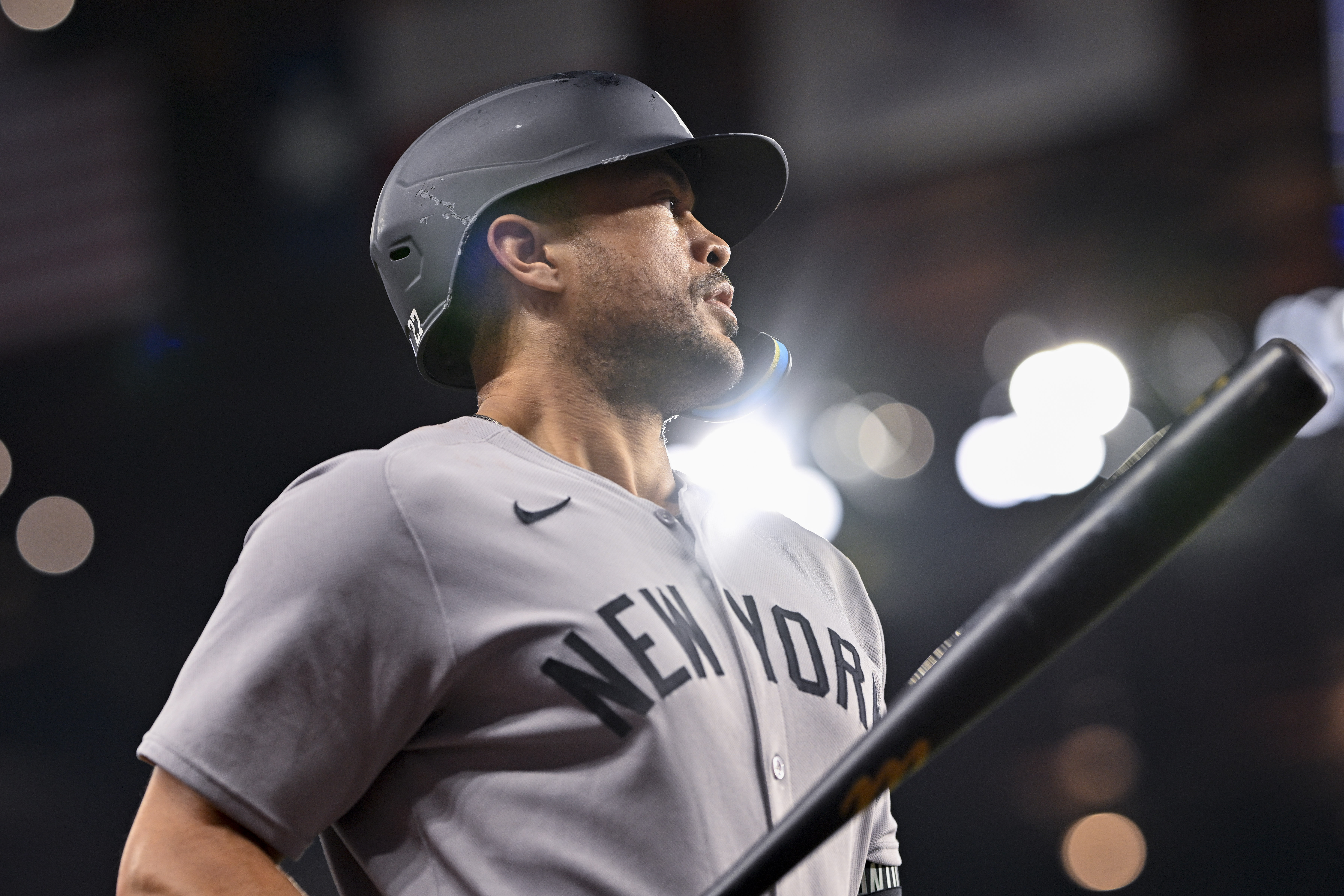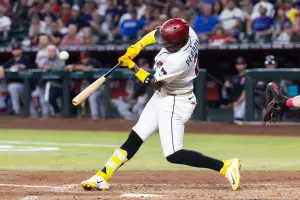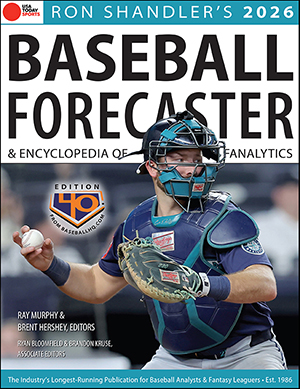
Swings and Takes: Cheap Power
Fantasy managers around this time in June are becoming fully aware of the strengths and weaknesses of their teams, and what areas they need to address. Not every need can be addressed with an asset heavy swing, however, so this week we are taking a shot at analyzing two hitters who could outproduce their current power paces, and potentially be acquired at affordable prices. These hitters have warts (or else they would be more expensive) and have not fully maximized their power output yet, but we have reasons to believe that is coming.
Waiting on a Met with Bated Breath
Mets fans have been waiting for a few years now to see which player, if any, of Mark Vientos (3B, NYM), Ronny Mauricio (2B, NYM), or Brett Baty (3B, NYM) would develop into their third basemen of the future. That question is still very much up in the air, as all three have had significant ups and downs throughout their minor and major league careers. Among those three, Baty has had the most interesting 2025 to date, as his player profile has evolved in a very interesting direction, both for better and for worse.
Going into 2025 Baty had a very uncertain future, as his minor league production (career .283/.382/.507 in 1434 PA) way outshined his pre-2025 MLB production (.215/.282/.325 in 602 PA). Notably, the power Baty had always been lauded for throughout his minor league career was nowhere to be seen at the major league level.
Baty has taken a small step forward on the surface in 2025, as his .229/.273/.431 line is closer to league average than his pre-2025 production, but below the surface he has taken larger steps forward in some facets.
While Baty has always shown near top of the shelf level max exit velocities as a MLB player, consistently around the 90th percentile (EV of the hardest single ball hit for a player) and showing elite raw power, he had never consistently made use of that raw power. He is now showing signs he may be closer to tapping into that raw power, as after hitting way too many ground balls for a power hitter in his previous MLB sample, in the 50-55% range, Baty is finally getting the ball in the air, with a 43.9 GB% so far in 2025. To use an old baseball saying, there is no slug on the ground, and Baty lifting the ball is crucial to his profile.
To go along with lifting the ball, it is important for power hitters to pull the ball in the air. Baty, after being well-below average in his first two MLB exposures (2022-2023) in that area, getting only 10-12% of his batted balls pulled in the air, has been above-average in that area for the last two seasons, sitting in the 18% range.
Baty is doing a better job of getting to his ideal types of batted balls, and underlying that change in batted ball profile is a massive increase in MLB bat speed. He was slightly above-average in bat speed at 73.5 mph in 2024, but has picked up 2.3 mph in 2025 to bring him up to 75.8 mph. His percentage of “fast swings”, or swings greater than or equal to 75 mph, is up from 38% in 2024 to roughly 58% in 2025. As Baseball Savant has researched, getting to fast swings really matters in terms of results, as non-fast swings from 2023-2024 generated a .246 BA and .369 SLG, while fast swings slashed .307 BA and .603 SLG.
Baty is getting his “A Swing” off much more often in 2025 than he did in 2024, and his average bat speed is 12th among qualified hitters in 2025, between James Wood (OF, WAS) and Austin Riley (3B, ATL). Most of the guys near the top of this bat speed leaderboard are among the top power hitters in baseball, and Baty is showing that kind of raw potential.
While we have waxed poetic about the potential Baty is showing so far in 2025, there are concerns. Baty in his minor league career was known as a patient hitter with a good idea of the strike zone. So far in 2025 he has not been making particularly good decisions, as his Chase Rate is below average (38th percentile), which in tandem with a 29th percentile Whiff Rate has led to poor K% and bb% numbers (27.1% and 5.2% respectively).
For a hitter like Baty you could take an elevated Whiff Rate because of swinging hard and trying to hit the ball out, but chasing, while taking an above-average (and career high) 18.1 CS%, shows a hitter who has not figured out his MLB decisions yet. Baty also needs to hit breaking balls, as his .186 BA and .251 wOBA against them in 2025 are in line with his previous MLB struggles against breaking pitches. If he starts to tap into his raw power, MLB pitchers will reduce the 54% fastballs he is currently getting and increase the 30% breaking balls.
Outlook:
Baty has secured strong-side platoon playing time in 2025, partially on the merit of much improved defense at two positions (3B and 2B). He is showing signs of getting closer to tapping into his elite raw power, but plate discipline and performance against breaking balls are the limiting factors. He could be a semi-cheap source of power production for fantasy managers down the stretch.
Benny Barrels
Andrew Benintendi (OF, CHW) has had a very odd MLB career. He started out as one of the premier prospects in the sport for the Red Sox, produced for roughly a league average level throughout his Boston career, then increased his value with a very good 1.5 years in Kansas City and an okay post-trade deadline stint with the Yankees. Benintendi capitalized on his KC emergence and age (going into his age 28 season) to sign the largest contract in White Sox history in the 2023 offseason, five-years, $75M (not a typo, as any White Sox fan will tell you). In a White Sox uniform he massively underwhelmed in 2023 before showing slight improvement in 2024 (popping 20 HR in 135 games, albeit with a .229 BA).
The hitter we are seeing in 2025 is an evolution upon the new approach he took in 2024. From 2022-2023 Benintendi hit a combined 10 HR in two full seasons, and after hitting 20 in 2024 he is on pace to exceed that in 2025. As a tradeoff seemingly for this increased power, Benintendi’s K% has gone up 4%, to sit around 18% each year from 2024-2025, after being in the 14% range from 2022-2023.
On the surface, with these changes, it could look like Benintendi is essentially doing the same thing as 2024, but he is not. He is lifting the ball like never before, as his ground ball rate is down over 10% from 2024 at 27%, nearly 13% below his career average.
In concert with this reduction, Benintendi’s average launch angle is way higher than it has ever been, at 22.8 degrees, which is six degrees greater than 2024 and seven degrees higher than league average. His average launch angle rising is not a good or bad thing within itself, but when coupled with the fact that his Launch Angle Sweet Spot% (balls hits between 8-32 degrees, included in a visual below) is 42%, nearly 9% greater than league average, it becomes a positive.
Launch Angle Chart

In addition to getting the ball in the air, Benintendi has also been elite at pulling the ball in the air, as his 33% mark is over 10% better than his career best and is fourth-best in the league right now. He is hitting a lot of balls in ways that usually generate great results, and we can further see that in his .510 xSLG, his career high by over 60 points.
Benintendi is accomplishing all of this with improved, but still subpar, average bat speed at roughly 69 mph, about one mph greater than 2024. His swing path has always changed, as he is roughly four degrees steeper in attack angle than he was in 2024, and seven degrees steeper than 2023. Benintendi’s Swing Length has also gotten a lot longer, at 7.2 feet, compared to 6.7 in 2024 and 6.6 in 2023. His swing path has also become more pull-oriented. Here is a visual of Benintendi's swing in early 2024, before he incorporated his current toe tap, and a recent clip from 2025:
Benintendi 2024
Benintendi 2025
The toe tap, which he started experimenting with in July of 2024 and calcified into its current form in August, allows Benintendi to be in better control of his movements. With his leg kick, he was often late getting his foot down and rushing with his upper body, while now he looks ready to hit earlier with better connectivity in his swing. Some guys really struggle with the type of two-part load Benintendi is utilizing, as it is hard to keep all of the moving pieces in sync, but for him it appears it is allowing him to relax in the box and be on time more consistently.
These mechanical changes are very concrete evidence for explaining why Benintendi is pulling the ball more and why he is getting the ball in the air more, as he is on time to produce this type of optimal contact, and his mechanics are following to be a bit steeper and more pull oriented.
Outlook:
Benintendi has shown himself to be a smart and adaptable hitter throughout his career, trying many different approaches to varying levels of success. There are some very interesting indicators that a power surge could be coming for him if he maintains this approach, both statistical and mechanical. He is operating in a manner like José Ramirez (3B, CLE) and Isaac Paredes (3B, HOU), two hitters who have turned below-average raw power into plus power production by orientating their approach towards it.
These changes may allow for a small mid-career surge for Benintendi, as we have plenty of examples of hitters who find an adjustment to get to power mid-career through swing changes.
There is some concern that long-term this may not be sustainable for Benintendi, as selling out to pull the ball for power at a career-high rate is often the approach for smart hitters who know they cannot effectively operate the way they used to. Raúl Ibañez 2023 and Joey Votto 2022 are two examples of this, and even though they were a bit older than Benintendi is now (30), it is something to be cognizant of. That being said, Benintendi is much younger than those guys were, and he may be able to sustain it for longer than one season.
Almost!
You’re just a few clicks away from accessing this feature and hundreds more throughout the year that have a singular goal in mind: Winning your league. Subscribe to BaseballHQ.com here!
Already a subscriber? Sign in here








